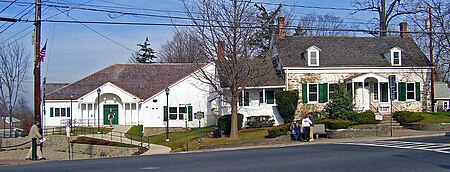The Wallkill Valley Rail Trail is a 23.7-mile (38.1 km) rail trail and linear park that runs along the former Wallkill Valley Railroad rail corridor in Ulster County, New York, United States. It stretches from Gardiner through New Paltz, Rosendale and Ulster to the Kingston city line, just south of a demolished, concrete Conrail railroad bridge that was located on a team-track siding several blocks south of the also-demolished Kingston New York Central Railroad passenger station. The trail is separated from the Walden–Wallkill Rail Trail by two state prisons in Shawangunk, though there have been plans to bypass these facilities and to connect the Wallkill Valley Rail Trail with other regional rail-trails. The northern section of the trail forms part of the Empire State Trail.Plans to create the rail trail began as early as 1983, when New Paltz considered uses for the then-defunct Wallkill Valley rail corridor; the railroad had ceased regular traffic in 1977 and, by 1983, had begun to remove its tracks. In 1991, a local land trust, the Wallkill Valley Land Trust, purchased the 12-mile (19 km) section of the former rail corridor between New Paltz and Gardiner, and conveyed the New Paltz section to the town and village of New Paltz with permanent land protection agreements, held by the Wallkill Valley Land Trust. The trail was formally opened between New Paltz and Gardiner in 1993, though Gardiner did not purchase its section from the Wallkill Valley Land Trust until 2007: again, with a land protection agreement placed on it. The length of the trail was effectively doubled by an Ulster County unpaid-tax foreclosure land seizure, in 2009. The Wallkill Valley Land Trust, in partnership with Open Space Institute, acquired the additional property from Ulster County and began several capital campaigns to open-up public access. The extension included the Rosendale trestle, a 940-foot (290 m) bridge across Rondout Creek. There are several other bridges that carry the trail, though none are as long.
The trail serves hikers, joggers, bikers, horseback riders and cross-country skiers. It passes through several historic districts, such as Huguenot Street in New Paltz, and the Binnewater Historic District and Snyder Estate in Rosendale. The trail also traverses U.S. Route 44 (concurrent with State Route 55), and state routes 299 and 213. Several natural features are visible from clear points along the trail, such as the Shawangunk Ridge to the west and the Plattekill Creek between New Paltz and Gardiner. The trail passes through dense vegetation, and is frequented by many types of animals and overwintering birds.










